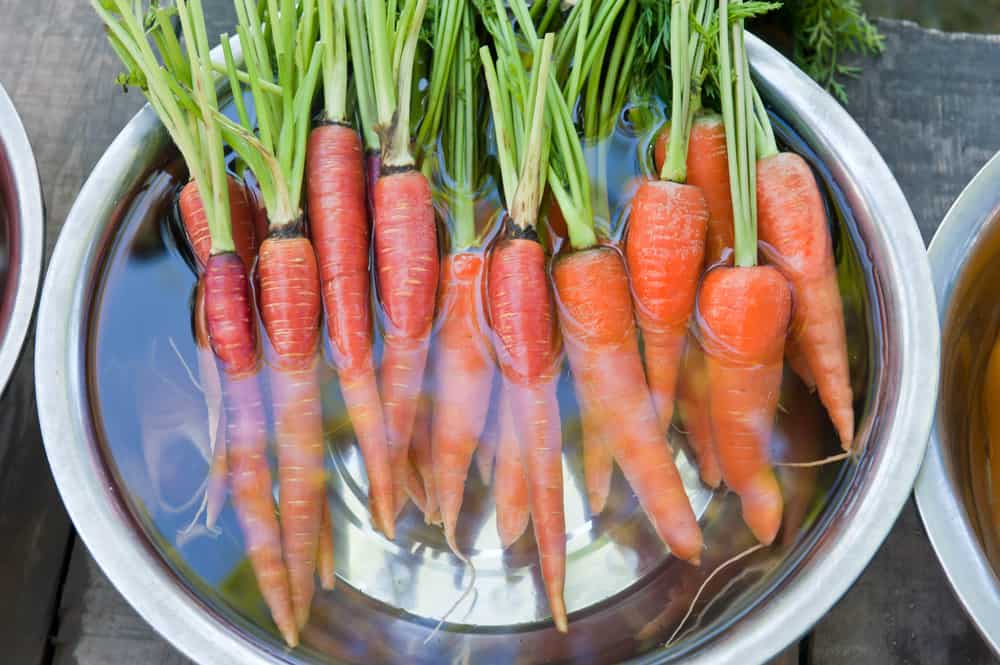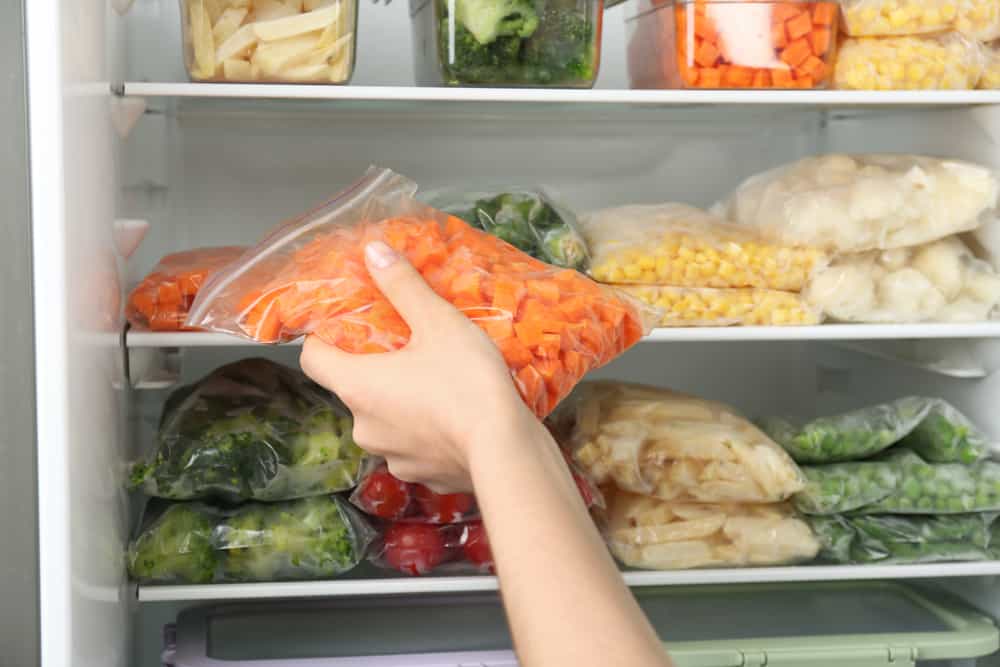
Carrots are a hardy root vegetable that is in season between early September until December. They are high in beta carotene, Vitamin K1, fiber, and antioxidants. They are commonly linked to an improvement in optical health and a decreased risk of cancer.
Western carrots are most commonly found in orange but also come in white, yellow, purple, and red. They have a water content ranging from 86 to 95% meaning that they are very hydrating.
They also contain biotin, potassium, and Vitamin B6. Biotin is used for protein metabolism and potassium is used to regulate your blood pressure.
Table of Contents
In water

You will first need to remove the leafy greens from the top of your carrots. These draw moisture out through the root to keep the greens in good condition. This will cause your carrots to become limp and desiccated.
You need to keep fresh and unpeeled carrots wet. The best way to do this is to cover them in water and store in the refrigerator. This could be in a ziplock bag or a large airtight container. Seal tightly or cover with plastic wrap and store in the refrigerator.
You should replace the water with a fresh supply once every 4 to 5 days when you notice the water turning cloudy. This method is particularly effective for peeled carrots.
If you want to store cut carrots in the refrigerator you should use a similar method. Soak them in a container of cold water covered loosely with kitchen towels or plastic wrap.
This method will keep your carrots fresh and in perfect condition for easily up to a month. You should not store them near to apples, pears, or bananas. This is because these fruits produce a gas called ethylene as they ripen. This gas accelerates the ripening of other produce and so can cause your carrots to go off sooner.
In the refrigerator
Line the vegetable crisper drawer in your refrigerator with a few layers of kitchen towel. Remove the leaves from the carrots, wash, and dry them thoroughly.
Change this kitchen towel out once every few days as it becomes damp. For a more eco-friendly method, use dishcloths.
Alternatively, you can wrap clean and dry carrots in aluminum foil or plastic wrap. Place these inside an airtight container and seal before placing them in the refrigerator.
You can store cut carrots in the refrigerator in a second way. Dampen some sheets of kitchen towels and wrap these around the carrots.
You can also store the cut-off green leafy sections of carrots in the refrigerator. These are ideal for using in soups, pesto, and smoothies as they contain a lot of beneficial nutrients, including 6 times the amount of vitamin C found in the carrots themselves.
To store, wrap them up tightly in a damp paper towel or dishcloth. These can keep for around 1 week like this.
Cool, dark places
Carrots, apples, and other root vegetables can be stored well in a cool and dark area. This could be a pantry or root cellar.
If you are planning on washing your carrots before storing them, we would advise against this. They will remain moist which will increase the risk of mold development. Again, ensure you remove all leaves and stems from the top of the carrots before storage.
Place the carrots in a large bucket or box with a lid. Fill it with leaves, moist sand, or sawdust and layer in the carrots. Cover the top and close the lid. This will mean that your carrots stay fresh for up to 6 months.
In the freezer

Freezing carrots will preserve a lot of the natural vitamin and mineral content found in them. Over time, fresh produce will lose their nutrient levels naturally and freezing is one of the best ways to lock these in.
We suggest storing them in a double layer of ziplock bags, with as much of the air pressed out as possible. For even better storage, we suggest vacuum sealing them.
Be aware that although this will help to keep your carrots for longer, the colors and flavor can change while in the freezer due to the natural enzyme activity.
Before freezing carrots, we advise blanching them to reduce the enzyme activity. To do this, peel your carrots and add them to a pan of boiling water. Allow them to sit in this for a minute or two and then immediately submerge in a large bowl of iced water.
Transfer the blanched carrots to your storage container and place them in the freezer until you wish to use them. Carrots frozen in this way can be stored for up to a year.
In an earth clamp
This involves leaving the carrots in the earth outside. You will need to pick a spot where you know that the soil drains well and is sheltered from the elements.
Take a large spade and dig a hole roughly 6 inches deep. Pour an inch or two of special horticultural sand into this hole.
Lie the carrots you are storing in a flat layer on top of the sand bed. They should not be touching one another. Cover the carrots with a second layer of sand.
Cover the top layer of sand with a thick layer of clean and dry straw.
Throw a thick layer of soil on top of the sand and straw. If you do this correctly in late autumn, the carrots will keep until at least the beginning of spring.
If you have a large number of carrots to store, you can use the same principle. Make a large circle in the ground, about a meter in diameter. Pour in a layer of sand and then make a circle of carrots with the necks facing the outer edge of the circle.
Layer up the carrots to make a pyramid. Cover with a 30cm deep layer of straw and then soil. Cover with a layer of plastic sheets for extra insulation.